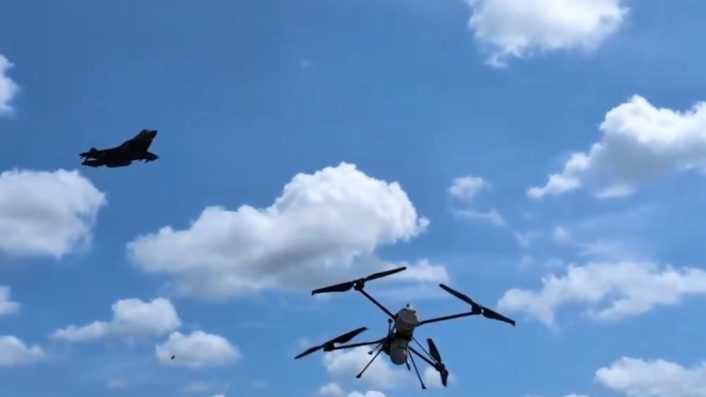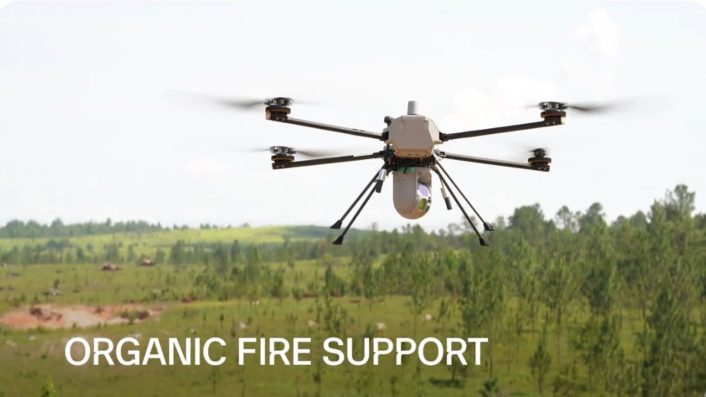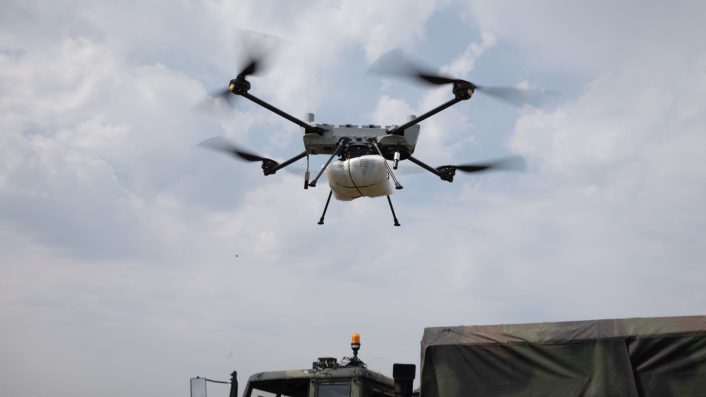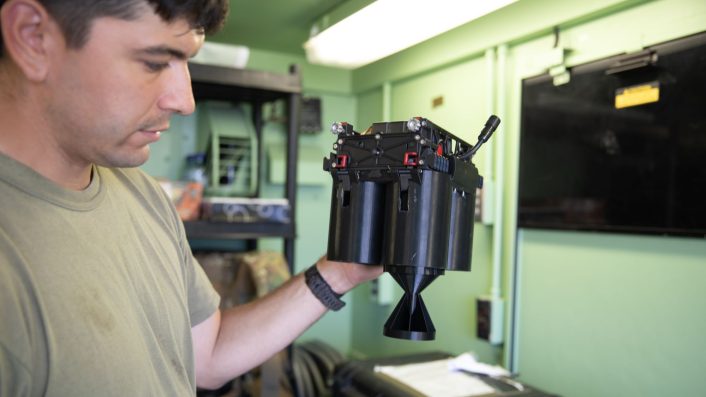PDW’s C100 quadcopter, which has also been acquired by the U.S. Army, was used to safely lase targets from a standoff range, demonstrating a new joint fires capability.
Performance Drone Works (PDW), a U.S. AI and drone technology company, revealed last month an “organic unmanned aerial system (UAS) fire support test” where its proprietary C100 quadcopter-type multipurpose drone was paired with a U.S. Air Force F-35A Lightning II. Using a Leonardo DRS STAG5 Laser Target Designator (LTD) mounted underneath the C100, the UAS “successfully guided four inert GBU-12 Paveway II precision munitions released from F-35 to predetermined targets,” PDW said on Jul. 23, 2025.
The company released the footage of the test on Aug. 12, showing the inert GBU-12s landing on a target, with the C100 lasing it from progressively longer ranges at 1000, 1,500 and 2,000 meters and capturing the impact on all three instances. While the F-35A is not seen releasing the GBU-12, the beginning of the promotional video shows both the jet and the C100 in a single frame, where the jet streaks overhead at low altitude, and the latter is much lower in the foreground.
One operator. One drone. Precision F-35 targeting from cover – no other aircraft required. #C100 pic.twitter.com/wtZ4NGsV9L
— PDW (@PDW_ai) August 12, 2025
We reached out to PDW for more details about the test, but at the time of writing we have not yet received a response and we will update this article once we have more info.
PDW’s Group 2-class C100 UAS is also finding use in the U.S. Army. The service announced on Aug. 3, 2025 its 173rd Airborne Brigade is acquiring four PDW C100 drones and a “fleet of custom-built first-person view (FPV) drones” in line with the latest trends in land warfare.
Unmanned precision in the field. Putting the #C100 and our latest capabilities through their paces. #PDW #UAS pic.twitter.com/aSHnnPVrz6
— PDW (@PDW_ai) July 29, 2025
In fact, Soldiers from the 173rd AB’s 1st Squadron, 91st Cavalry Regiment designed, assembled and repaired many drone components using 3D-printing and soldering. For the C100, they also built grenade launchers and payload attachments for tactical battlefield delivery/logistics.
The C100 pushes the boundaries of what’s possible on the battlefield.
U.S. Secretary of Defense @SecDef @PeteHegseth and Polish Deputy Prime Minister Wladyslaw Kosiniak-Kamysz visited the Army Prepositioned Stocks-2 (APS-2) site in Powidz, Poland where PDW’s C100 was showcased… pic.twitter.com/zGsIjYIt6k
— PDW (@PDW_ai) February 16, 2025
The test
The Air Force has not released any information on the test with the F-35. However, PDW’s description of the parameters and intended impacts suggests an ability to allow forward Joint Terminal Attack Controllers (JTAC) to more safely coordinate Close Air Support (CAS) and airstrikes from standoff distances.
“This exercise demonstrated the ability of an operator to safely mark targets from a standoff range with the C100 for joint fires capabilities without need for supporting aircraft,” PDW said in its press release. This means that the F-35A, which cannot be expected to fly at lower altitudes to visually identify land targets, does not have to rely on other low-flying aircraft or larger drones for that function.

For instance, a June 2024 bilateral U.S.-Philippine live-fire drill saw Marine F-35Bs dropping GBU-32 JDAMS on floating targets, after they were identified by Philippine Navy drones and a C-130. On the other hand, in the PDW test, for the three separate engagements at ranges of 1,000, 1,500, and 2,000 meters between the C100 and the target, the C100 loitered for approximately 35 minutes and was separated by 3 km from the operator, capturing “a detailed visual description, enabling rapid target acquisition.”
The Paveway II is a guidance kit converting Mk.80 bombs into a precision munition, in this case a Mk.82 500 pound bomb in a GBU-12, and has a range of more than 14.8 km. The Paveway II Plus version, that is field programmable and offers improved accuracy, can also be installed on the Mk.84 2,000 pound bomb, becoming the GBU-10, and Mk.83 1,000 pound bomb, becoming the GBU-16.
Screengrabs of the test’s video showed the GBU-12s striking the land targets one after the other. The F-35A can carry GBU-12s both in its internal weapons bays and externally on the underwing pylons.

In this case, the jet might have carried one GBU-12 inside each of the bays, and the other two under the wings, or all fours externally, although two F-35s might have been present and not only one. On Feb. 25, 2016, F-35As from the 388th and 419th Fighter Wings based at Hill AFB, Utah, became the firsts from an operational F-35 Lightning II combat unit to drop GBU-12s.
Utility
PDW said that the C100 is an “organic fires platform” that extends soldiers’ effectiveness with a versatile payload suite supporting ISR, target designation, and kinetic effects. “This is the second in a series of demonstrations aimed to prove the C100 as the ultimate organic fires platform,” PDW CEO and co-founder Ryan Gury said in the press release. “The C100 offers a huge leap in tactical flexibility for the warfighter and PDW is ready to equip our forces with a system that can provide that support across various domains.”

The demonstration with the F-35 validated the C100’s ability to allow “integrating LTD capability for rapid target handoff to indirect fire, close air support, and maritime platforms.” As a stand-off targeting solution, the C100’s “organic precision lasing from extended ranges” reduces exposure of ground-based JTAC teams to adversary detection. They are further away from the target, with the drone providing the laser designation, while also allowing the F-35’s stealth capabilities to be used in land strike situations.

C100
The U.S. Army press release about the annual multinational Agile Spirit 25, held at Norio Training Area in Georgia on Aug. 2, 2025, said the C100 has a range of up to 10 kilometers and a flight endurance of 74 minutes. “The PDW C100 allows small units to push supplies or conduct reconnaissance deep into the battlespace without maintaining line-of-sight; an advantage especially critical in mountainous or contested terrain,” the statement added.

The drone is supported by four long legs for landing, four fold-out arms each carrying a two-bladed rotor, and is portable enough to be accommodated on the back of a land tactical vehicle. The U.S. Army’s press release quoted Staff Sgt. Nathaniel Daniels, platoon sergeant, who said the PDW C100 expands even further on the tactical use cases.
“Today, we saw the PDW C100 mission sets, able to drop speedballs or any [medical] supplies to a main or forward aid station,” Daniels explained. “If the mission is beyond 2 or 3 kilometers, we can upload the mission, and the drone will complete it autonomously and return.
PDW’s website and YouTube videos show the C100 being able to carry a variety of EO (Electro-Optical) sensors, small gravity bombs, tactical resupply payloads and being a mothership to smaller FPV drones and UGV (Unmanned Ground Vehicles), meeting the full-range of logistics, ISR and strike needs.
PDW announced on Dec. 23, 2024 landing a $15.3 million contract from the U.S. Army’s for the C100 in support of its ‘Transformation in Contact’ initiative. The service will deploy it in the Indo-Pacific Command (INDOPACOM), European Command (EUCOM), and Central Command (CENTCOM).
In the same press release, PDW added that the Army also selected the C100 for its Directed Requirement for Company-Level sUAS (small UAS), providing soldiers with “medium-range reconnaissance and tactical air support in contested environments.”









